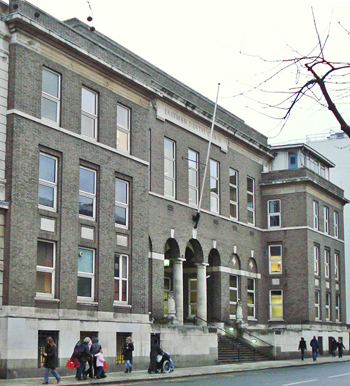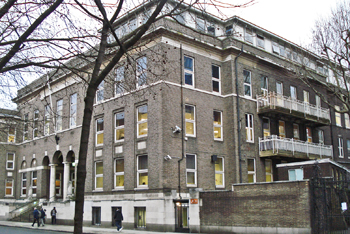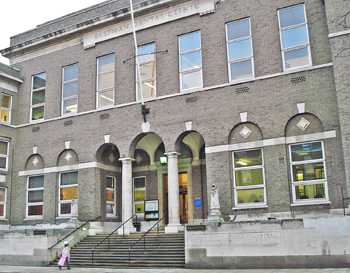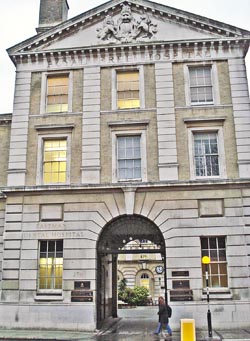Dental
In 1926 the philanthropist George Eastman (1854-1932), founder of the Eastman Kodak Company, offered funding to the Royal Free Hospital to establish a dental clinic similar to the one he had enabled to be built in Rochester, New York in 1917. Eastman believe that good dental care, oral hygiene and dietary care, especially for children, was an essential part of preventive medicine. He offered an initial sum of £200,000 to pay for a new building, on the understanding that the Royal Free Hospital would provide an endowment to maintain the clinic.
A subsequent endowment of £100,000 was provided by Lord Riddell, President of the Hospital, and Sir Albert Levy, its Honorary Treasurer.
The foundation stone for the dental clinic was laid on 30th April 1929 by the Prince of Wales. The site was adjoining the south side of the Royal Free Hospital in Grays Inn Road.
The Eastman Dental Clinic opened on 17th November 1930 (it was officially opened on 20th November 1931 by Charles G. Dawes, the American ambassador). The Clinic provided free dental care for the children of Finsbury, Holborn, Islington and St Pancras - four of the poorest London boroughs. Soon 500 treatments a week were being performed.
On the ground floor of the building was a large waiting room for the children, which contained a large bird cage (as did the other Eastman Dental Clinics established in Rome, Brussels, Stockholm and Paris). Artists had also been employed to paint murals illustrating nursery rhymes and childhood themes. The ground floor also contained an office for the Director, a Board Room and various administrative offices, and a Lecture Room equipped with a lantern slide projector and cinematograph. There were also treatment rooms for adult patients.The first floor contained 68 chairs and electrical units - 50 in the main treatment room, 12 in the Orthodontic Department, 3 in the children's extraction rooms and 3 in the adult operating rooms. An X-ray Department and a Photographic Department were located on this floor.
The surgical wing consisted of 37 beds in three wards for children needing hare lip and cleft palate repair, removal of tonsils and adenoids, and treatment for other oral, throat, nose and ear conditions. Special provision was made for nursing and expectant mothers.
In the basement were lecture rooms for the nursing staff.
During WW2 the building received considerable damage from a flying bomb, as did its neighbour, the Royal Free Hospital.
In 1948 the Clinic became independent of the Hospital, joining the NHS as a postgraduate teaching hospital - the Eastman Dental Hospital. The Institute of Dental Surgery had been established the previous year as a postgraduate school attached to the Hospital, under the aegis of the British Postgraduate Medical Federation. The Institute had its own management committee.
Once the war damage had been repaired, the building was considered attractive, airy and modern, and quite suitable for its special use.
In 1988 the Hospital and Institute expanded to occupy the vacant buildings of the Royal Free Hospital, which had moved to new premises in Hampstead in 1974.
In 1992 the Institute was renamed the Eastman Dental Institute. In 1996 the Board of Governors of the Hospital was abolished and the Hospital became part of University College Hospital. In 1999 the Institute joined University College London.
In 2001 the Hospital had 12 beds.
Present status (January 2008)
The original Clinic building was Grade II listed in August 2007.
The Hospital is internationally renowned for its specialist services, including cleft restorative, orofacial pain and orthognathic clinics. There are also clinics for patients with hypodontia and craniofacial deformity.
Update: July 2015
The Hospital is due to close in 2016, as is the Royal National Throat Nose and Ear Hospital. Services will move to the new centre to be built on the site of the Royal Ear Hospital in Capper Street. The buildings will be sold off to pay for the project.

The 1930s building is Grade II listed.

The southern elevation looks over St Andrew's Gardens.

The central section of the building bears the legend 'Eastman Dental Clinic'.

The Hospital and Institute now also occupy the former buildings of the Royal Free Hospital.
(Author unstated) 2007 The Eastman at 60 - a history of the UCL Eastman Dental Institute. British Dental Journal 203, 551-554.
Black N 2006 Walking London's Medical History. London, Royal Society of Medicine Press.
Brayer E 2012 George Eastman: a Biography. University of Rochester Press.
http://en.wikipedia.org
www.britishlistedbuildings.co.uk
www.flickr.com (1)
www.flickr.com (2)
www.ucl.ac.uk
www.uclh.nhs.uk (1)
www.uclh.nhs.uk (2)
www.urmc.rochester.edu (1)
www.urmc.rochester.edu (2)
www.urmc.rochester.edu (3)
www.urmc.rochester.edu (4)
Return to home page